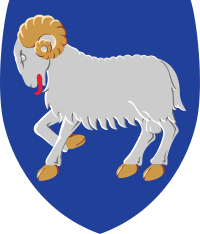2012 Faroese municipal merger referendum
A municipal merger referendum was held in the Faroe Islands on 3 May 2012. Proposals were put forward for merging the thirty existing municipalities into seven new municipalities, with voters in each of the proposed new areas voting on the merger. The proposition was rejected in six of the seven proposed new municipalities. As a result, none of the mergers went ahead.[1]
 |
|---|
| This article is part of a series on the politics and government of the Faroe Islands |
|
|
|
The unity of the Realm
|
|
Regeringen
The Government of Denmark
Landsstýri
The Government of the Faroe Islands
Privy Council
|
Folketinget
Parliament of the Kingdom of Denmark (69th Kingdom Parliament)
|
|
|
Foreign relations
|
|
Related topics
|
Background
Proposals for municipality mergers and delegating powers to municipalities had been discussed for 20–25 years prior to the referendum.[2] The Centre Party, People's Party and Social Democratic Party were in favour of voluntary mergers, whilst the Self-Government Party, Republic and Union Party favoured creating the mergers by legislation. Progress advocated for drafting legislation on the mergers and submitting it to voters through a referendum.[3]
In the autumn of 2011, the Faroese government announced that it would be transferring responsibility for elderly care and primary education from 1 January 2014, and that the number of municipalities would need to be reduced from the 30 that existed at the time.[4] A referendum on the merger proposals was announced by Interior Minister Kári P. Højgaard on 20 December 2011, which was based on section 7 of the Act on Voluntary Municipal Mergers and Inter-municipal Cooperation on Statutory Services. Anyone eligible to vote in municipal elections was able to vote in the referendum.[5]
Proposed mergers
| Proposed municipality |
Existing municipalities | Population (1 January 2012) |
|---|---|---|
| Eysturoy | Fuglafjørður, Eystur, Nes, Runavík, Sjóvar | 9,451 |
| Norðoyar | Fugloy, Húsar, Hvannasund, Klaksvík, Kunoy, Viðareiði | 5,821 |
| Sandoy | Húsavík, Sandur, Skálavík Skopun, Skúvoy | 1,325 |
| Streymoy | Kvívík, Tórshavn, Vestmanna | 21,601 |
| Suðuroy | Fámjin, Hov, Hvalba, Porkeri, Sumba, Tvøroyri, Vágur | 4,676 |
| Sundalagið | Eiði, Sunda | 2,334 |
| Vágar | Sørvágur, Vágar | 3,076 |
| Source: Hagstova[6] | ||
Results
Vágar, where the merger process was already underway, was the only proposed municipality area in which voters approved the proposals. Although there were majorities in some individual municipalities, these were largely areas that were expected to become the centre of the new municipality; only three of the peripheral municipalities voted in favour.[1]
| Proposed municipality |
For | Against | Invalid blank |
Total | Registered voters |
Turnout | Result | ||
|---|---|---|---|---|---|---|---|---|---|
| Votes | % | Votes | % | ||||||
| Eysturoy | 36.3 | 63.7 | 2,964 | 6,929 | 42.8 | Rejected | |||
| Norðoyar | 47.6 | 52.4 | 1,149 | 4,351 | 26.4 | Rejected | |||
| Sandoy | 47.6 | 52.4 | 555 | 1,008 | 55.1 | Rejected | |||
| Streymoy | 27.8 | 72.2 | 3,508 | 15,763 | 22.2 | Rejected | |||
| Suðuroy | 34.5 | 65.5 | 1,729 | 3,558 | 48.6 | Rejected | |||
| Sundalagið | 41.1 | 58.9 | 569 | 1,690 | 33.7 | Rejected | |||
| Vágar | 63.3 | 36.7 | 1,163 | 2,227 | 52.2 | Accepted | |||
| Total | 11,637 | 35,526 | 32.8 | ||||||
| Source: KVF[7] Folketing[8] | |||||||||
References
- Beinta í Jákupsstovu (2017) "National goals and local values. Changes in the municipal structure and gender representation in the Faroe Islands" NORKOM
- "Kommunusamanlegging: Sterkari lokalt fólkaræði og økismenning". Løgmansskrivstovan (in Faroese). 2 May 2012. Archived from the original on 1 January 2014. Retrieved 24 July 2013.
- "Tað er galið við spurningunum, ikki við føroyingum". Progress (in Faroese). 30 May 2012. Retrieved 24 July 2013.
- "Samgonguskjal millum Sambandsflokkin, Fólkaflokkin, Miðflokkin og Sjálvstýrisflokkin" (PDF). Løgmansskrivstovan (in Faroese). 2011. Retrieved 24 July 2013.
- "Vegleiðandi fólkaatkvøða um kommunusamanlegging" (PDF). Innlendismálaráðið (in Faroese). 30 March 2012. Retrieved 24 July 2013.
- "Fólkatalið 1. januar skift á býir/bygdir og kyn". Hagstova Føroya (in Faroese). Archived from the original on 26 February 2012. Retrieved 24 July 2013.
- "32,7% atkvøddu á vegleiðandi fólkaatkvøðuni". Kringvarp Føroya (in Faroese). 3 May 2012. Retrieved 24 July 2013.
- Rigsombudsmanden på Færøerne: "Indberetning nr. 3/ 2012" (J.nr. 323-1-dmk) Folketing